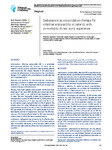Dalbavancin as consolidation therapy for infective endocarditis in patients with comorbidity: a real world experience

View/
Use this link to cite
http://hdl.handle.net/2183/40282
Except where otherwise noted, this item's license is described as Creative Commons Attribution-NonCommercial 4.0 International License (CC-BY-NC 4.0)
Collections
Metadata
Show full item recordTitle
Dalbavancin as consolidation therapy for infective endocarditis in patients with comorbidity: a real world experienceAuthor(s)
Date
2024-06-17Citation
Brandariz-Núñez D, Luances-Rodríguez A, Feijoo-Vilanova P, Gutiérrez-Urbón JM, Ramudo-Cela L, Martín-Herranz MI, Margusino-Framiñán L. Dalbavancin as consolidation therapy for infective endocarditis in patients with comorbidity: a real world experience. Rev Esp Quimioter. 2024 Aug;37(4):334-340.
Abstract
[Resumen]
Objective: Infective endocarditis (IE) is a potentially life-threatening infection, the incidence of which has in creased in recent decades, particularly among elderly patients with comorbidity. The primary objective of this study was to evaluate the effectiveness of dalbavancin in the consolidation therapy of IE in patients with comorbidity six months after the end of treatment (EOT).
Methods: An observational and retrospective study was conducted on patients with a Charlson Comorbidity Index (CCI) ≥ 3 who were diagnosed with IE and received consolidation therapy with dalbavancin.
Results: Forty-eight patients were included, 58.3% were male, mean age of 76.2 years (IQR: 66-88), and a mean age adjusted CCI of 6.5 (IQR: 5-7.5). Definite IE was diagnosed in 77% of cases. The most frequently isolated microorganisms were Staphylococcus aureus (45.8%) followed by Enterococcus spp. (31.3%). Complications of IE were observed in 67.7% of cases, and cardiac surgery was performed in 27% of patients. The primary reason for using dalbavancin was outpatient parenteral antibiotic therapy in 85.4% of cases. The effectiveness at EOT was 93.8%. At six months, six IE-related deaths, four unrelated deaths, and two IE relapses were observed. The effectiveness was 77%. Adverse effects related to DBV were reported in 4.2% of cases, of which 2% were considered serious.
Conclusions: Dalbavancin has proven to be an effective alternative as consolidation antibiotherapy for IE in elderly patients with comorbidity. Moreover, a very favorable safety profile with few associated adverse effects has been observed in this population. [Resumen] Introducción. La endocarditis infecciosa (EI) es una infección potencialmente mortal, cuya incidencia ha aumentado en las últimas
décadas, especialmente entre los pacientes ancianos con comorbilidad. El objetivo primario de este estudio fue evaluar la eficacia de
dalbavancina en la terapia de consolidación de la EI en pacientes
con comorbilidad seis meses después del final del tratamiento.
Material y métodos. Se realizó un estudio observacional y
retrospectivo en pacientes con un Índice de Comorbilidad de
Charlson (ICC) ≥ 3 diagnosticados de EI y que recibieron terapia de consolidación con dalbavancina.
Resultados. Se incluyeron 48 pacientes, 58,3% varones, edad
media de 76,2 años (IQR: 66-88) y un ICC ajustado por edad
medio de 6,5 (IQR: 5-7,5). Se diagnosticó EI definitiva en el
77% de los casos. Los microorganismos aislados con mayor
frecuencia fueron Staphylococcus aureus (45,8%) seguido de
Enterococcus spp. (31,3%). Se observaron complicaciones de la
EI en el 67,7% de los casos, y se practicó cirugía cardiaca en el
27% de los pacientes. El motivo principal del uso de DBV fue
la terapia antibiótica parenteral ambulatoria en el 85,4% de
los casos. La eficacia al final del tratamiento fue del 93,8%. A
los seis meses, se observaron seis muertes relacionadas con EI,
cuatro muertes no relacionadas y dos recaídas de EI. La eficacia
fue del 77%. Se notificaron efectos adversos relacionados con
la DBV en el 4,2% de los casos, de los cuales el 2% se consideraron graves.
Conclusiones. Dalbavancina ha demostrado ser una alternativa eficaz como antibioterapia de consolidación para la EI en
pacientes ancianos con comorbilidad. Además, en esta población se ha observado un perfil de seguridad muy favorable con
escasos efectos adversos asociados.
Keywords
Dalbavancin
Infective endocarditis
Comorbidity
Infective endocarditis complications
Dalbavancina
Endocarditis infecciosa
Comorbilidad
Complicaciones de endocarditis infecciosa
Infective endocarditis
Comorbidity
Infective endocarditis complications
Dalbavancina
Endocarditis infecciosa
Comorbilidad
Complicaciones de endocarditis infecciosa
Description
Observational study
Editor version
Rights
Creative Commons Attribution-NonCommercial 4.0 International License (CC-BY-NC 4.0)
ISSN
0214-3429






